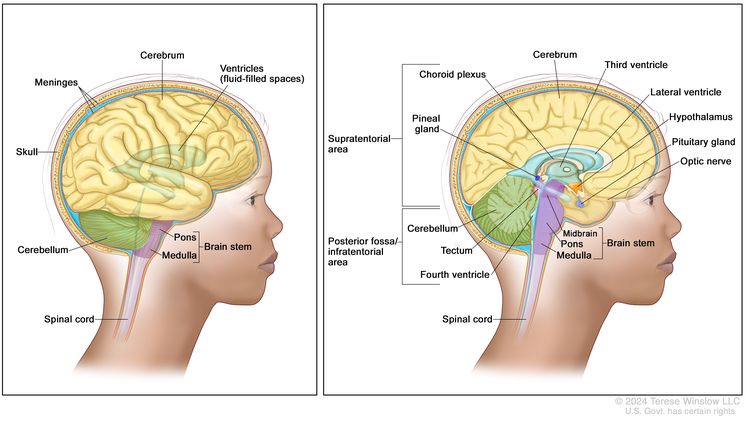Childhood Astrocytomas Treatment (PDQ®)–Patient Version
General Information About Childhood Astrocytomas
KEY POINTS
- Childhood astrocytoma is a disease in which benign (noncancer) or malignant (cancer) cells form in the tissues of the brain.
- Astrocytomas may be benign (not cancer) or malignant (cancer).
- The central nervous system controls many important body functions.
- The cause of most childhood brain tumors is not known.
- The signs and symptoms of astrocytomas are not the same in every child.
- Tests that examine the brain and spinal cord are used to detect (find) childhood astrocytomas.
- Childhood astrocytomas are usually diagnosed and removed in surgery.
- Certain factors affect prognosis (chance of recovery) and treatment options.
Childhood astrocytoma is a disease in which benign (noncancer) or malignant (cancer) cells form in the tissues of the brain.
Astrocytomas are tumors that start in star-shaped brain cells called astrocytes. An astrocyte is a type of glial cell. Glial cells hold nerve cells in place, bring food and oxygen to them, and help protect them from disease, such as infection. Gliomas are tumors that form from glial cells. An astrocytoma is a type of glioma.
Astrocytoma is the most common type of glioma diagnosed in children. It can form anywhere in the central nervous system (brain and spinal cord).
This summary is about the treatment of tumors that begin in astrocytes in the brain (primary brain tumors). Metastatic brain tumors are formed by cancer cells that begin in other parts of the body and spread to the brain. Treatment of metastatic brain tumors is not discussed here.
Brain tumors can occur in both children and adults. However, treatment for children may be different than treatment for adults. See the following PDQ summaries for more information about other types of brain tumors in children and adults:
Astrocytomas may be benign (not cancer) or malignant (cancer).
Benign brain tumors grow and press on nearby areas of the brain. They rarely spread into other tissues. Malignant brain tumors are likely to grow quickly and spread into other brain tissue. When a tumor grows into or presses on an area of the brain, it may stop that part of the brain from working the way it should. Both benign and malignant brain tumors can cause signs and symptoms and almost all need treatment.
The central nervous system controls many important body functions.
Astrocytomas are most common in these parts of the central nervous system (CNS):
- Cerebrum: The largest part of the brain, at the top of the head. The cerebrum controls thinking, learning, problem-solving, speech, emotions, reading, writing, and voluntary movement.
- Cerebellum: The lower, back part of the brain (near the middle of the back of the head). The cerebellum controls movement, balance, and posture.
- Brain stem: The part that connects the brain to the spinal cord, in the lowest part of the brain (just above the back of the neck). The brain stem controls breathing, heart rate, and the nerves and muscles used in seeing, hearing, walking, talking, and eating.
- Hypothalamus: The area in the middle of the base of the brain. It controls body temperature, hunger, and thirst.
- Visual pathway: The group of nerves that connect the eye with the brain.
- Spinal cord: The column of nerve tissue that runs from the brain stem down the center of the back. It is covered by three thin layers of tissue called membranes. The spinal cord and membranes are surrounded by the vertebrae (back bones). Spinal cord nerves carry messages between the brain and the rest of the body, such as a message from the brain to cause muscles to move or a message from the skin to the brain to feel touch.

The cause of most childhood brain tumors is not known.
Anything that increases your risk of getting a disease is called a risk factor. Having a risk factor does not mean that you will get cancer; not having risk factors doesn’t mean that you will not get cancer. Talk with your child's doctor if you think your child may be at risk. Possible risk factors for astrocytoma include:
- Past radiation therapy to the brain.
- Having certain genetic disorders, such as neurofibromatosis type 1 (NF1) or tuberous sclerosis.






















.png)











No hay comentarios:
Publicar un comentario